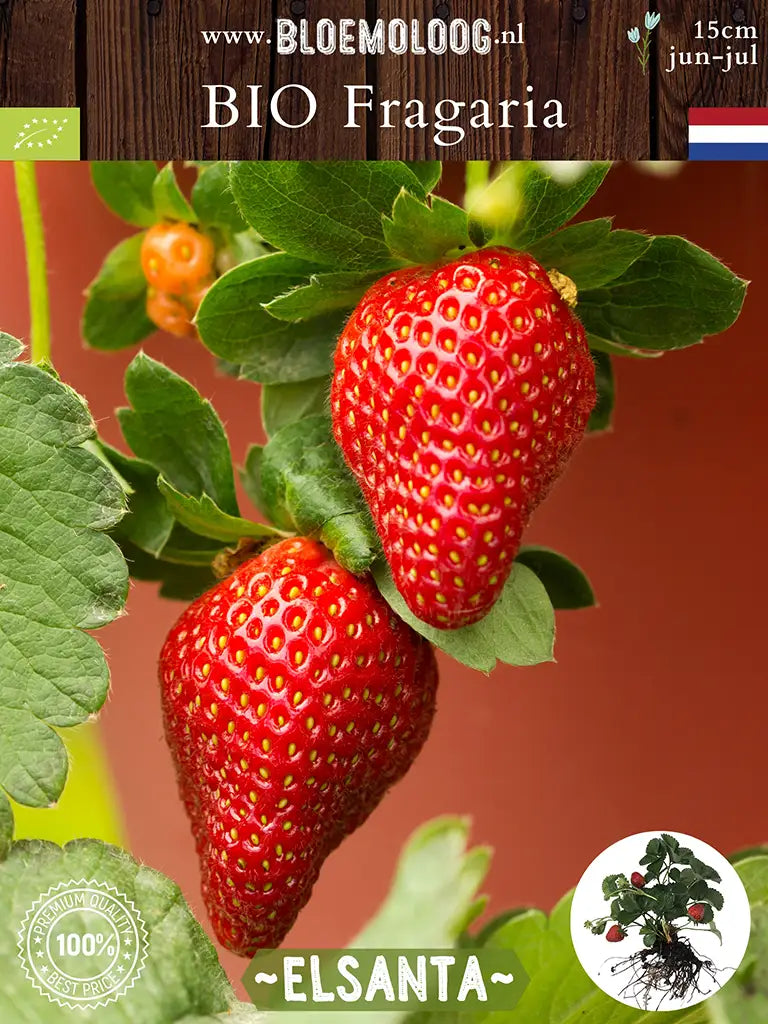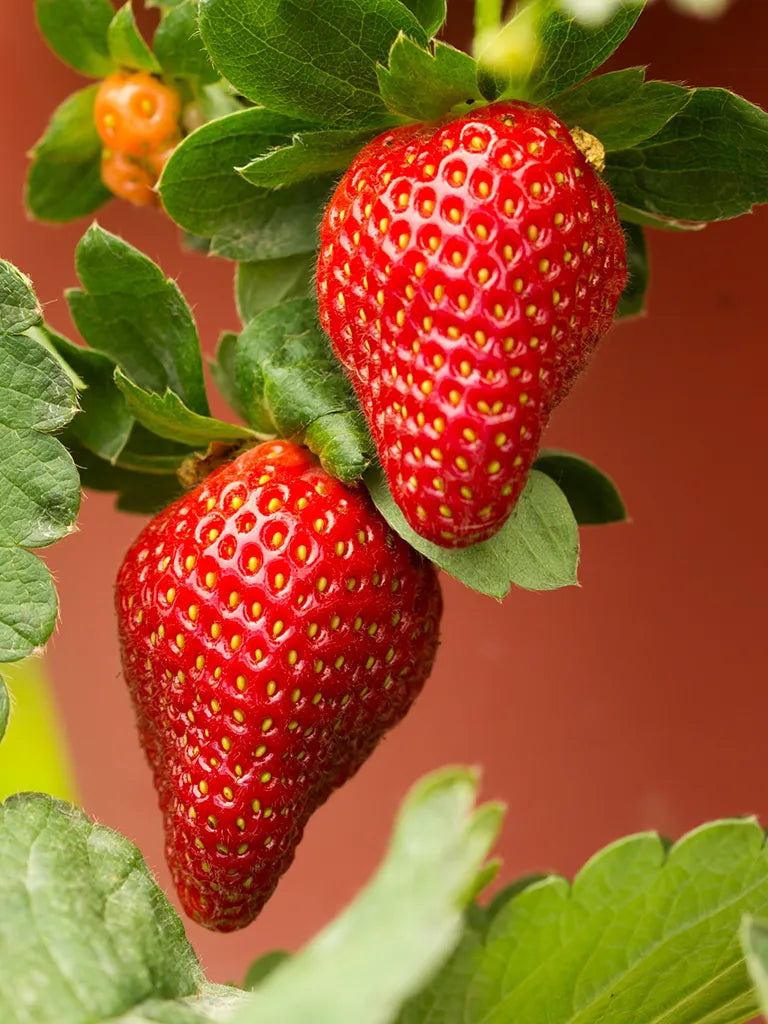Bloemoloog
Estimated Shipping Widget will be displayed here!
Couldn't load pickup availability
Organic strawberries
The Fragaria ananassa 'Elsanta' is a strawberry plant that ripens its fruits in mid-June and excels in size and firmness. The 'Elsanta' strawberry is known for its impressive, firm fruits that are not only large in size, but also have a remarkably long shelf life, so you can enjoy this delicious delicacy for longer.
The flowering of the 'Elsanta' is characterized by moderately large flowers with well-developed stamens, although the stamens of the first flowers are sometimes less pronounced. In terms of productivity, this variety exceeds expectations, with a remarkably high yield of first quality fruits.
The growth of the 'Elsanta' is impressive and quite wide, with sufficient openness and beautifully long, sturdy fruit bunches. What makes this strawberry extra special is the fact that the fruits can be picked easily and quickly, making the harvesting process efficient and enjoyable.
The 'Elsanta' strawberry is a winter-hardy perennial plant. It returns every year and grows in size.
Note! You buy the bare roots of this strawberry plant.
How, where and when do I plant strawberry plants?
Plant the roots of the strawberry plant in the ground immediately upon delivery. Plant the 'Elsanta' in a place with plenty of sunlight. Strawberries thrive best in well-drained, fertile soil. Dig a hole of about 10 centimeters and spread the roots over the ground and fill the hole with soil. Allow the new green shoots to stick out just above the ground and provide sufficient water.
Care of a strawberry plant
Provide good general plant care, including regular watering, removing weeds from around the plant, and applying appropriate fertilizers. This contributes to the health and vitality of the strawberry plant.
Organic fertilizers, such as compost or well-rotted manure, can be used to nourish strawberry plants. These not only add nutrients, but also improve soil structure.
Protection against frost
If there is still a risk of frost after the appearance of the first flowers, consider protective measures. Frost can damage the flowers and thus affect fruit formation. Cover the plants with cloth or garden fleece if frost is predicted.
Remove the first flowers
It is often beneficial to remove the first flowers from strawberry plants. This is also called "deflowering". By removing the first flowers, you direct the plant's energy toward developing strong roots and healthy chlorophyll rather than toward fruit production. This helps the plant to grow stronger and generate a larger harvest in subsequent flowering periods.
While removing the first blooms can be beneficial for overall plant health, it is also important to leave some blooms standing. This allows the plant to reproduce and eventually produce fruit. Once the plant is well established, you can leave more flowers to encourage fruiting.
Pollination
Strawberries need pollination to produce fruit. If you notice that there are few bees or other pollinating insects in your garden, you may consider gently pollinating the flowers with a soft brush. By gently stroking the flowers, you imitate the action of a pollinating insect and help fruit formation.
Health benefits
Strawberries are not only known for their delicious taste, but also for their health benefits. They are rich in vitamin C, antioxidants and dietary fiber, and are often considered a healthy addition to the diet.
History of the strawberry
Wild strawberries are native to many parts of the world, including North America, Europe and Asia. People have collected and eaten wild strawberries for centuries for their pleasant taste and supposed health benefits.
The cultivation of strawberries began in Europe in the 14th century. Initially, wild strawberries were collected in forests and fields. However, European gardeners soon began selectively breeding strawberries to obtain larger, sweeter fruits.
Strawberries gained royal recognition in the 14th century when they were planted in the gardens of the French royal court. King Charles V of France is often cited as an early lover of strawberries.
Strawberry festivals became popular in the United States in the 19th century. Often held in the spring, these events marked the start of strawberry season and were an opportunity for communities to come together and enjoy strawberries in various dishes.
Today, strawberries are one of the most popular and cultivated berries in the world. They are widely cultivated in various climates and are available all year round.
Buy Organic Fragaria 'Elsanta'
Skal NL-BIO-01 certified: 109459
Packed per 3 pieces or choose a stacking discount.
Stacking discount: C
Can be ordered from January '26!
EU shipping €8.95 - Free shipping from €100 purchase.
Characteristics
| Flowering time: | June - July |
| Planting time: |
Spring |
| Planting depth: |
2 cm underground |
| Planting distance: | 30 cm apart |
| Height: |
15 cm high |
| Flower diameter: |
3cm wide |
| Location: |
Partial shade, sun |
| Soil PH: | Loam, sandy soil - Slightly acidic/neutral |
| Winter hardiness: |
Winter hardy |
| Propagation: | Good |
| Family: | Rosaceae (rose family) |
| Group: |
Pineapple |
| Colour: | White (red fruit) |
| Bee-friendly: | Yes |
| Fragrant: | No |
| Quality: | Cutting |

NL-BIO-01
To share




